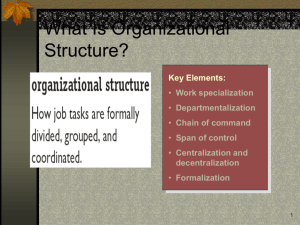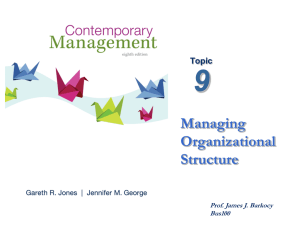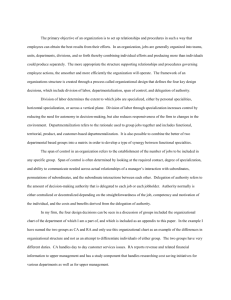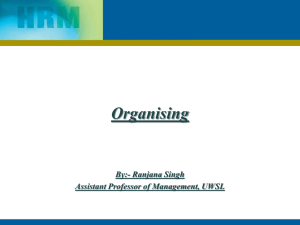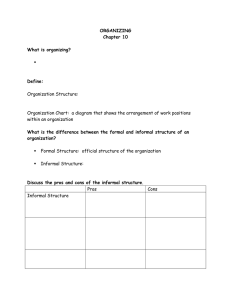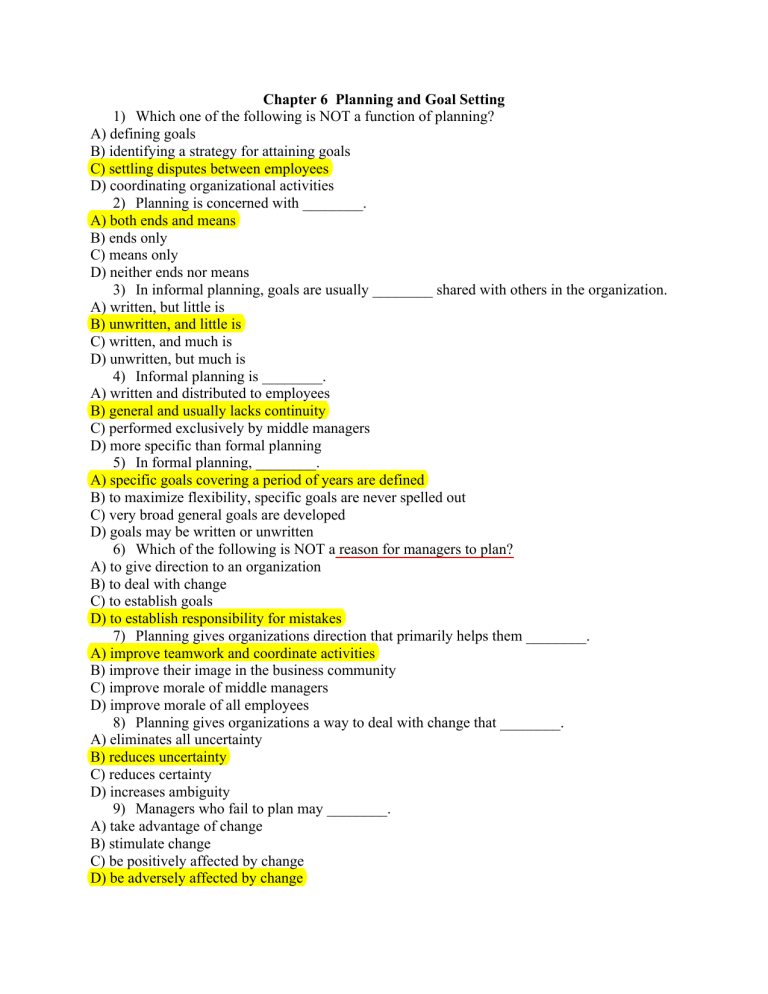
Chapter 6 Planning and Goal Setting 1) Which one of the following is NOT a function of planning? A) defining goals B) identifying a strategy for attaining goals C) settling disputes between employees D) coordinating organizational activities 2) Planning is concerned with ________. A) both ends and means B) ends only C) means only D) neither ends nor means 3) In informal planning, goals are usually ________ shared with others in the organization. A) written, but little is B) unwritten, and little is C) written, and much is D) unwritten, but much is 4) Informal planning is ________. A) written and distributed to employees B) general and usually lacks continuity C) performed exclusively by middle managers D) more specific than formal planning 5) In formal planning, ________. A) specific goals covering a period of years are defined B) to maximize flexibility, specific goals are never spelled out C) very broad general goals are developed D) goals may be written or unwritten 6) Which of the following is NOT a reason for managers to plan? A) to give direction to an organization B) to deal with change C) to establish goals D) to establish responsibility for mistakes 7) Planning gives organizations direction that primarily helps them ________. A) improve teamwork and coordinate activities B) improve their image in the business community C) improve morale of middle managers D) improve morale of all employees 8) Planning gives organizations a way to deal with change that ________. A) eliminates all uncertainty B) reduces uncertainty C) reduces certainty D) increases ambiguity 9) Managers who fail to plan may ________. A) take advantage of change B) stimulate change C) be positively affected by change D) be adversely affected by change 10) Studies of planning show that the key to successful planning is to make sure that the plans ________. A) cover every possible detail B) are high in quality C) are exceedingly simple to follow D) are not shared with employees 11) In studies in which formal planning did not lead to higher performance, ________ usually the culprit. A) unforeseen events in the environment were B) demanding employees were C) stubborn ownership was D) lack of communication was 12) Formal planning typically leads to which one of the following? A) higher profits B) lower productivity C) higher sales, but lower profits D) tension between different management levels 13) All managers plan in some way, either formally or informally. Answer: TRUE/FALSE 14) Informal plans are not recognized as true organizational plans and are rarely carried out by managers. Answer: TRUE/FALSE 15) At some point, all managers create formal plans. Answer: TRUE/FALSE 16) Planning provides direction to managers and non-managers alike. Answer: TRUE/FALSE 17) A key function of planning is to create goals. Answer: TRUE/FALSE 18) Informal planning typically works better in large organizations than in small organizations. Answer: TRUE/FALSE 19) The four reasons that organizations plan are to establish coordinated effort, set standards, minimize waste, and reduce uncertainty and the impact of change. Answer: TRUE/FALSE 20) Planning rarely improves teamwork and cooperation among employees. Answer: TRUE/FALSE 21) An organization that fails to plan will find it hard to assess progress. Answer: TRUE/FALSE 22) A criticism of formal planning is that it focuses too much on groundbreaking visions and deals with ideas that are too innovative to work. Answer: TRUE/FALSE 23) A major strength of formal planning is that it reinforces past successes and incorporates them into the future. Answer: TRUE/FALSE 24) A major strength of formal planning is that it gives an organization rigidity. Answer: TRUE/FALSE 25) A major strength of formal planning is that it generally correlates with higher profits. Answer: TRUE/FALSE Chapter 7 Structuring and Designing Organizations 26) Organizational design requires a manager to ________. A) decide who leads a group within an organization B) change the culture of an organization C) change or develop the structure of an organization D) change the logo of an organization 27) All of the following are part of the process of organizational design EXCEPT ________. A) deciding how specialized jobs should be B) determining rules for employee behavior C) determining the level at which decisions are made D) determining goals for the organization 28) Which one of the following pairs include items that are NOT basic elements of organizational design? A) work specialization, span of control B) chain of command, line authority C) centralization, decentralization D) departmentalization, formalization 29) Which one of the following is synonymous with work specialization? A) division of labor B) job discrimination C) chain of command D) job preference 30) Which statement accurately defines work specialization? A) It is the degree to which tasks are grouped together. B) Individual employees specialize in doing part of an activity rather than the entire activity. C) Jobs are ranked relative only to their worth or value to the businesses. D) Work specialization clarifies who reports to whom. 31) Today, managers favor this approach with regard to work specialization. A) All tasks are performed by all employees to promote fairness. B) Partners switch jobs every half hour to overcome boredom. C) Employees specialize to maintain efficiency. D) Monotonous tasks are shared by all employees to prevent perceived favoritism. 32) Functional departmentalization groups jobs by ________. A) tasks they perform B) territories they serve C) products or services they manufacture or produce D) type of customer they serve 33) ________ departmentalization is based on territory or the physical location of employees or customers. A) Functional B) Product C) Geographic D) Matrix 34) A soap company that features a bath soap department, a laundry detergent department, and a dish soap department is using which one of the following? A) process departmentalization B) functional departmentalization C) product departmentalization D) customer departmentalization 35) The line of authority that extends from the upper levels of management to the lowest levels of the organization is termed the ________. A) chain of responsibility B) unity of command C) staff authority D) chain of command 36) The chain of command answers this question. A) Where do I go for help? B) How do I know when the task is complete? C) What are the rules? D) Who reports to whom? 37) Authority gives an individual the right to do this. A) give orders B) reprimand employees C) command respect D) obey orders 38) In the chain of command, each person above you ________. A) has special privileges B) receives higher pay C) has line authority D) has no right to give you orders 39) Staff managers have authority over ________. A) support employees only B) line managers C) middle managers D) the person above them in the chain of command 40) Line authority gives a manager the ability to direct the work of ________. A) any employee in the firm B) any subordinate C) any subordinate, after consulting with the next higher level D) only subordinates one level down 41) ________ prevents a single employee from getting conflicting orders from two different superiors. A) Line authority B) Unity of command C) Staff authority D) Chain of command 42) The importance of unity of command has diminished in today's workplace because of its tendency to be ________. A) inflexible and inefficient B) ethically questionable C) chauvinistic and dictatorial D) too decisive 43) ________ is the obligation or expectation to perform a duty. A) Responsibility B) Unity of command C) Chain of command D) Span of control 44) When a top manager decides to hire an individual over the objections of her staff, she is exercising which kind of power? A) referent B) expert C) coercive D) legitimate 45) The traditional view holds that managers should directly supervise ________ subordinates. A) no more than three B) no more than six C) around twelve D) around twenty 46) Modern managers find that they can ________ if their employees are experienced, welltrained, and motivated. A) increase their span of control B) decrease their span of control C) eliminate their span of control D) fluctuate their span of control 47) A traditional "top down" organization is ________ organization. A) a largely centralized B) a largely decentralized C) an absolutely decentralized D) an absolutely centralized 48) ________ reflects the degree to which decision making is distributed throughout the hierarchy rather than concentrated at the top. A) Centralization B) Span of control C) Concentration D) Decentralization 49) In recent years, organizations have become more ________ to be responsive to a dynamic business environment. A) centralized B) decentralized C) structured D) mechanistic 50) In today's decentralized business world, ________ the most important strategic decisions. A) top managers still primarily make B) middle managers make C) lower-level managers make D) nonmanagerial employees make
